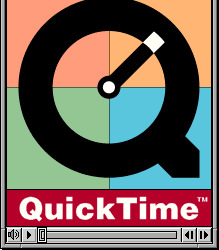#Openstep
Explore tagged Tumblr posts
Text
Domingo de Login Screens 4
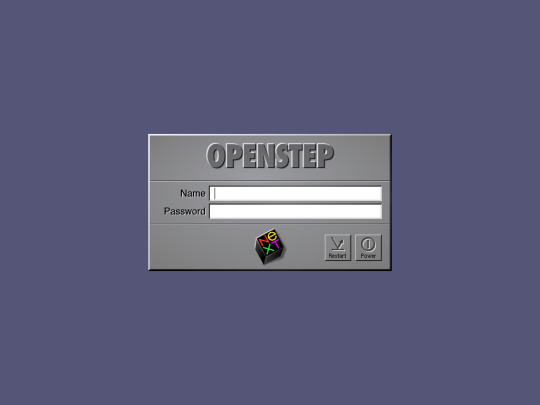

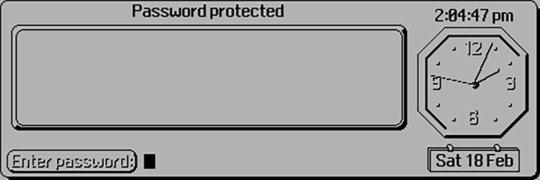
Ahora el turno de las pantallas de "login" de Sistemas Operativos Linux: 7.- Sibo 3 (EPOC que se convirtió en SymbianOS) 6- QNX 6.21 7.- OpenStep 4.2 (que se transformó en MacOS X) Si tienes algún otro, compártelas. ¿Cuál es tu favorito? #retrocomputingmx #LoginScreen #sibo #QNX #openstep
3 notes
·
View notes
Text
I'd vote for killing him while he's at NeXT. We get the Apple I and II, we get the early stuff from the Mac, we get OpenStep, but we don't get OS X or the iPhone and iOS, leaving PalmOS, Android, and the various incarnations of Windows Mobile as the contenders for smartphone OSes. (Keep in mind that the Palm Treo, Kyocera 6030 and 7135, HTC P4350, Compaq iPAQ, and others all predate the iPhone. The iPhone wasn't the fuse of the smartphone revolution, it was the barrel of gunpowder exploding.)
The question isn't "should we kill Steve Jobs?" but "when do we kill Steve Jobs?"
1K notes
·
View notes
Text
Macデスクトップ構築まとめ:
ステージマネージャーガチ勢になった
広義の環境構築が趣味なので、改めてMacのデスクトップ周りの設定をした
以前はGeekToolを導入し「クソダサフルーツポンチ」などと罵倒されて闇堕ちしそうになったが、めげずにいい感じの作業環境を整えたい
「ステージマネージャー」��使い始めた
macOS Venturaで登場した「ステージマネージャー」を使い始めたことがきっかけで、デスクトップの使い方を変えた
ステージマネージャーを使い始めたきっかけは、マルチディスプレイの枚数が増え、タスクごとに大量のウインドウを切り替えることが億劫になってきたこと
調べ物→Web会議→コーディング...などと切り替えていると、自分が10分前に何をしていたのか本当にわからなくなってくる
MacのMission Controlには以前からデスクトップの作成と切り替えが備わっていて利用していたのだが、作業ごとにいちいちデスクトップを作成している暇はない
ステージマネージャーは逆にごちゃついて見えるが
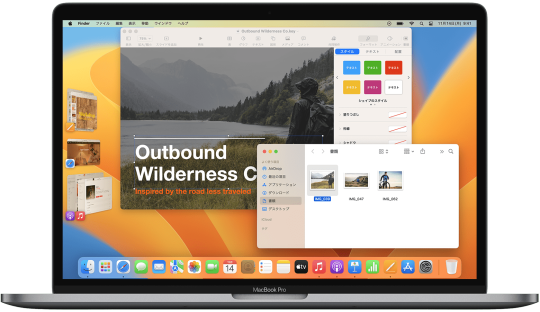
ステージマネージャーの最大の利点は、フォーカスしているウインドウに集中できること
それならフルスクリーン表示で良くない?と思っていた
左(左Dockなら右に)にウインドウが避けるが、画面構成がごちゃごちゃして見えないか?狭い画面向けの苦肉の策でしか無い?と思っていた
機能がDockと被るなら、Dock常時要らなくない?と気付いた

Dockを非表示にしたところ、すごくしっくり来た
改良版NEXTSTEP/OPENSTEPみたいでいいじゃないかと思った
ウインドウがダークモードなので、単色の白背景(画像は"Silver")にすると左のウインドウがアイキャンディになって、めちゃめちゃかっこいい

作業をしていても集中できていい感じ
Dockを隠すようにしたので、起動しっぱなしのアプリとか、ごみ箱を空にすることをいちいち考えなくて済むようになった
ウインドウは左のウインドウリストからドラッグして持って来ればまとめておける
ダッシュボード的なウインドウセットを用意しておき、空いているディスプレイ向けやSNSの閲覧用に展開する使い方が便利
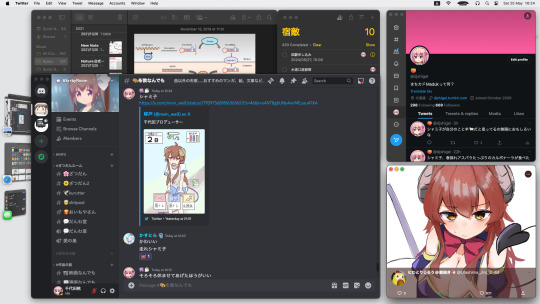
メリット
デスクトップがよりシンプルになった
マジで集中力が上がった
マルチディスプレイ環境において、ウインドウの整理が早くなった
反対に、小さい画面でも使いやすくなった
一度ウインドウの組み合わせが決まると、デスクトップを新たに増やすよりも手軽に、セットを切り替えられるようになった
デメリット
アプリを起動したり切り替えたりするとウインドウが入れ替わるので、動きは激しくなった
同時に異なるウインドウを開いておきたいとき、「ウインドウが入れ替わる...→手動で左からウインドウを引っ張ってくる...」という手間は生じるようになった
Extra: Mission Controlと併用して使おう
とは言え、ウインドウセットをいちいち切り替えてメールや日程を確認する...といった使い方は使いにくい
しかも、おなじみの4本指左右(2本指ダブルタップ)で素早く切り替えられるのも捨てがたい

そこで、以前から使っているデスクトップ切り替えを併用して使う
例えばよく見るメールとカレンダーは、それらをまとめたデスクトップを作るか、フルスクリーン分割にしてしまおう
メールや日程の確認は4本指左右で行う...
ウインドウセットやダッシュボードセットはクリックで開く...
...といった感じで、ジェスチャー別に開きたいものを開ける
Extra: Dockも弄ろう
非表示にしたDockだが、使うときは使う
画面下にカーソル→Dock→Launchpadを開くのは面倒
Dockでランチャーとして完結できるようにする

使う可能性が少しでもあるアプリは全部並べる
色相で並べ替える
大きさをあえて最小にし、拡大を大きくする
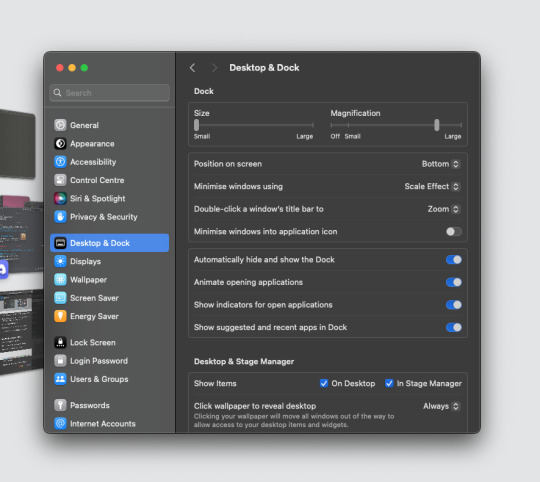
言葉で説明するのが難しいが、「目で見つけて探す」のではなく、不思議と「色彩や位置」の感覚でアプリを見つけられるようになる
Launchpadと違い画面が切り替わらないし、目線を動かさなくていい
新感覚
Extra: Launchpadも弄ろう
もともと2ページ目に、iPhoneやiPadのような「ライブラリ」を手動で作っていた
1ページ目にこのお手製ライブラリを持ってきて、全部集約した
Trackpadの「4本指でピンチ」でも開いたりできるので、これはこれで使える

0 notes
Text
Some code I've been meaning to perfect, but don't have the energy to.
I know this is a very sharp departure from what I used to post. I haven't had the energy to take them for a while; plus I'm fat now. Sorry about that. There was a good time when my boobs were big and the belly not as round -- more like triple-stacked -- but come on. We don't post nipples on this site.
I also didn't have enough energy to follow through on many of my things. A lot of them are still VERY USEFUL things to me at least, but everything's just too much of a drain. There's a possibility of someone also finding these things useful, so I figured a blog post will help make them somewhat findable with a search engine.
Well, I suppose GitHub pages would be a better place. But I've already got kind of a blog here...
Windows argument passing in node and cygwin
Python plistlib for openstep formats
Windows argument passing
The thing about command-line on Windows is that it's the wild west. Programs do not actually receive an argv[] array like you have been conditioned by C to believe; instead they get a "cmdline" string to do whatever the hell they want with it.
Still, in that sea of insanity, there is one constant. Regular programmers are lazy. They just use whatever the runtime library does with the command line. In these cases you get a somewhat predictable behavior -- "somewhat", because even amount Microsoft runtimes the behavior differs -- and you can write some sort of an escaping function.
Beyond the runtime, cmd.exe also has its own understanding of how quoting works. Most disgustingly, it understands where double-quoted parts start and end differently from msvcrt. I've got a trick for that.
Node
The node PR, at https://github.com/nodejs/node/pull/29576, is focused on quoting. It's got proper quoting for bash, pwsh, and cmd + msvcrt. It's got very strong test cases (throw them at other people's things: they might break!) and good documentation. What it didn't have is communication and rizz. You're advised to skip to the "files changed" tab.
The cmd "trick" is explained at https://github.com/Artoria2e5/node/blob/c0a6aff35cd3ff6d3bd0e3687776158e97466c93/lib/child_process.js#L850. The gist is that msvcrt and .NET treats two double-quotes as if it's an escaped double-quote. It's undocumented, sure, but Microsoft's own code relies on it.
doc/api/child_process.md has a good chunk of text explaining how Windows cmdline works and who deviates from the norm. And that leads to our next suspect: Cygwin.
Cygwin
Cygwin is the way to run POSIX things on Windows these days. Sure there's MSYS2, but guess what? It's a Cygwin fork. If you are using the official Windows build of git, you're using MSYS2, which in turn means you're using Cygwin code.
Cygwin is not msvcrt, obviously. But what's less obvious is that it doesn't process cmdline the same way. That bites you HARD when you want to run a Cygwin program on a file with weird characters.
The patchset at https://github.com/mirror/newlib-cygwin/pull/5, formerly a botched e-mail exchange ending with me being too tired to split the patchset (come on, it's almost impossible to have intermediate stages that build, let alone work!), was my answer to the problem. It rewrites the cmdline parser to be msvcrt-compatible, while still keeping the Unix-style globbing and @-expansion features.
It's fucking awesome is what it was. It's written in C++ with in-place processing. What else can you ask for.
Oh, in case you want to know what my current answer to the problem is: roll into a ball and cry.
Openstep plistlib
So if you use an Apple product and do things that Apple don't really like you to do, you have probably came across a "plist". Nowadays plists are either an opaque binary file or a very wordy XML. Back in the good old days plists were not like that at all: they read more like JSON, except they only supported strings and dicts.
Python's plistlib does not care about the old style. It should, because it's fucking beautiful. It's also as functional as the new stuff is, as long as you use the GNUStep extensions.
I wrote a Python package to do just that (or did I? does it work yet?). https://github.com/Artoria2e5/text-plistlib As far as I can recall it works on a round-trip smoke test, but some extension decisions needed to be hammered out. It uses tatsu though, so there's no chance of getting into the plistlib part of the standard library.
I think I've also got some other things related to this plist format open somewhere. I wanted to write a parser for opencore to cut down on this XML misery, but COME ON IT'S C. I can't even keep track of a plain recursive descent parser in Python (why else am I using a parser generator?), to do it in C? No way. I'm also too lazy to learn yacc, thank you very much.
Other things
something about https://marc.info/?l=openssh-unix-dev&m=168509072920594&w=2
Dream the DRM receiver/broadcaster has bad Opus options. Dev said I should open a branch. I think I can't, because I can't even get the official binary to run. I also lost my slightly illegal SDR kit.
I've definitely forgotten older things.
0 notes
Text
What Happened?

Why do I seem to have lost interest in everything computer related? I used to love playing with old machines but to be honest lately my heart has really fallen out of the industry.
I just don’t seem to enjoy playing with this stuff. I used to like messing around with emulators and playing with things like DOS but now I feel like I have played around and done most things I can do in that field.
I had an interest in Linux but to be honest it seems to have faded. Maybe because I have hit the limits of my hardware so I don’t have any areas to explore.
People have always said I have had an esoteric choice of machines I like. Although I admit my first machine was a 48k ZX Spectrum back in 1983 as common as you get. I have always been interested in the more obscure or failing machines.
I have always had an interest in machines such as the MSX machines, PC Engines & Sharp X68000. This is because they were not on every computer shop in town. They didn’t make huge impact at all in the UK where I am based.
Obviously a lot of the software is in Japanese and I have no ability to read Hiragana, which is what it normally is. So even if I get emulation running I have no idea what its about or what I am supposed to be doing if it’s beyond basic menus.
I also like machines like the NeXT, which was also not hugely available so when to get to see them I am really interested.
I then used OpenStep 3.3. via the emulator called Previous and really discovered how little software is actually available for this system. However using it really did show how much NeXTStep is still in Mac OS X even to this day.
Why do I prefer typing in old word processors like this one and Word Perfect 5.1 for DOS or LocoScript PC. Give me a copy of LibreOffice or Modern Word and I sit and stare at a blank page.
I also seem to type more if you give me a minimalist word processor like Writeroom or Focuswriter. So maybe it’s a psychological thing.
It seems the more obscure the item is the more my interest is.
I also have a vast interest in running things in emulators. I have no ability to write said emulators but have always had a fascination in seeing if I can do it on said machines.
It started when I got my first 486 SX25 . The first emulator I ran was JPP in DOS to emulate a ZX Spectrum. Then I found things like Z80 and Magic Engine I bought keys for both. The Magic Engine key I still have and still works but the Z80 one went AWOL a long time ago.
It was cool to subvert the machine make it doe something it was not designed by trade to do, It was exciting and when you got something working it was cool.
I then found things like Nesticle, (NES) Genecyst (Genesis/Mega Drive) and Callus (CPS1) from Blood software and I entered a rabbit hole of emulation. BSNES and ZSNES (both SNES ) and things like M72 (Irem M72 boards), RAINE (CPS1/2) and MAME.
Obviously I remember MAME when it started and would only run 5 games but it sharp managed to keep adding more and more games, making it very interesting at the time.
MAME of course is still going today and can do lots of things as it now includes many of the older projects being amalgamated into it. It now includes MESS, (Multi Emulation Super System), MFME (Multi Fruit Machine Emulator) and PINMAME (Pinball DMD roms).
All of these at one point had separate instances but now MAME coves them all including the ever growing arcade roms and architectures it supports.
As well as multi machine emulators like MAME. Several arcades had their own dedicated programs. I remember things like The New Zealand Story and the 4 player Teenage Mutant Ninja Turtles had their own dedicated emulators written for them.
Obviously over the years many emulators have come and gone and the images of the roms have been upgraded or updated. I think I saw recently that if you wan t to emulate some of the newer systems on MAME such as Sega M1 or Naomi upwards you need to use CHD (Compressed Hunks of Data) files and if you want a complete collection of such then you need over 10TB worth of hard drive space.
Which is ludicrous considering that half of them don’t work very well due to requiring a beefy CPU to run said games and lots of GPU memory to create the virtual graphics cards.
So machines without a eight-core processor or higher and anything less than a Nvidia 3000 series graphics card need not apply.
Over the years the emulators have continued covering all major platforms and even to this day as I said MAME continuers its quest. However even more recent platforms are not safe from the emulators.
They have emulation for Xbox 360, Playstation 2 & 3 and even a Switch emulator. In fact was just announced about RPCS4, Orbital, PS4EMX, PS4Emus they have got Playstation 4 emulation now in the functional stages.
Scary stuff. I love emulation even though I could not program one to save my life. I just like seeing a machine running something it was not intended to do.
This is also why I used to like playing with Hackintosh stuff because it was once again subverting what the machine is. The PC was not supposed to run Mac OS X but the fact that someone managed to get such things running was absolutely fascinating.
People have accused me of being quite brutal on machines because I tend to try and get these emulators to work or run software never designed for it. The fact that things such as emulators and the various VMs to run obscure stuff I am not the only one who wants to do this.
Thankfully they do exist because if you were waiting on me to write such it would never happen as I just don’t have that sort of skill or knowledge.
Of course the new Apple Silicon has pretty much made the Hackintosh redundant and also I really didn’t quite understand how to get OpenCore working it was far too complex for my limited brain.
Normal stuff like PC gaming or consoles don’t appeal to me very much until they become a challenge to run them. As I said I like the obscure I like the having to resort to unorthodox methods.
I would be the type if I did play PC games and got good I would have to beat Call of Duty 904 with a Steering wheel just be obnoxious. I’m not going to do that so don’t look to find it.
Obviously as I said new emulators require machines far beyond my reach at the moment but one day who knows I may get back up in the high end PC market again.
Until then I type this nonsense on a iBook G4 using Microsoft Word 2008 then probably upload it using my Dell i7 M6800 laptop to Tumblr.
However to answer the question what happened. I think I have played with most of the obscure things and now I have nothing to do or see.
Going back to the run of the mill is boring and I honestly find most modern games and consoles lifeless. They may be photo realistic and have 4k graphics and more but have about as much excitement to me as a pebble.
However if I get a high end PC I will definitely try and emulate the consoles I don’t care about currently as it something the PC isn’t supposed to be doing. As I said it’s a psychological thing or basically I’m just weird.
0 notes
Text
No one : A NeXTSTEP enthusiast from 2017: OPENSTEP and OpenStep are DIFFERENT!!!11!!!! one of them are API that was written after a negotiation with SUN (Microsytem, not the shit tabloid) while the OTHER is a PACKAGE to run OPENSTEP Binaries!!
source btw
0 notes
Note
I'm also gonna chime in here with an extra Bonus Reason: hardware compatibility. DOS and Windows, being the de facto standard platform, have the best driver support for your video cards, sound cards, motherboards, et cetera. I have tried installing the likes of OS/2 Warp 4, Red Hat 6.0, X86 Rhapsody, and OpenStep 4.2 on real hardware. They're extra, extra picky about what they work with. I think OpenStep didn't even like being booted from an IDE CD-ROM drive. (Or some other strange problem therein.) The old cliche in Linuxville was that nobody knows how to get sound working - well, that's basically the case if you're running an old enough vintage on anything but an original, genuine Sound Blaster Pro or 16. Let alone whether your OS of choice will know what your NVidia Riva TNT is, if it'll support enough VESA to bump the screen resolution past 640x480x16 colors, whether it'll know what to do with a Pentium II or if it'll kernel panic for no reason due to some freak combination of a motherboard it doesn't recognize and, I dunno, a system clock setting that it thinks is "preposterous."
A lot of old hardware was designed to a purpose, and that purpose was - far more often than not - Windows. So that's where most of the drivers are.
Why does everyone run old DOS/Windows on their vintage computers? Wouldn't it be nice to see one running OS/2 / ArcaOS, or SCO Unixware, or 386BSD, or AIX? I love your blog btw.
despite running an entire blog around old computers, i actually know very little about them. i just like the aesthetic lol
185 notes
·
View notes
Photo

Email client in NeXT OPENSTEP 4.2
124 notes
·
View notes
Text
Un día como hoy (26 de noviembre) en al computación



El 26 de noviembre de 1996, un día después de una llamada de un gerente de nivel medio de NeXT a Apple que planeta la posibilidad de licenciar el OpenStep para el nuevo SO para Mac, se da la llamada final y concreta con la que llegarían a un acuerdo entre las dos compañías. La charla se da entre Garrett Rice y Ellen Hancock, directora de tecnología de Apple. Este fue el primer paso entre las dos compañías que terminaría en acuerdo para que Jobs regresará a Apple y ésta obtuviera NeXTStep para crear el Mac OS X. Ellen Hancock (que falleció en abril de 2022) era una matemática contratada por Gil Amelio para sacar a flote el proyecto Copland, y ella misma fue quien canceló este proyecto. Lo vio inviable y deteriorado, y por lo tanto busco una nueva perspectiva que encontró en dos posibilidades: Solaris de Sun Microsystems o NeXT de Steve Jobs. Ella prefería la propuesta de Sun, pues a pesar que regresará Jobs, Hancock quería el Kernel de Solaris en el nuevo SO. A fin de cuentas, Hancock regresó a Jobs y éste le paso por encima #retrocomputingmx #ellenhancock #apple #Next #stevejobs
1 note
·
View note
Photo
NeXT

253 notes
·
View notes
Photo

Couple more of our Oak Stairs Complete by our Joiners, Solid oak Half Riser Open step design #oakstairs #oakstaircases #oaksteps #halfrisers #openstep #stairs #staircases #newbuild #newbuildstairs #oakwood #woodworking #joinery #joiners #stairmaster #carpentry #carpenter #shawstairs
#openstep#carpentry#staircases#oakstaircases#halfrisers#woodworking#oakstairs#stairs#joinery#carpenter#newbuildstairs#shawstairs#oakwood#oaksteps#stairmaster#joiners#newbuild
1 note
·
View note
Video
youtube
Mum Tries Out Rhapsody 5.1 (1998)
幾分かファンキーな演出だが、Rhapsodyの実演として役立つ動画か。この動画はRhapsodyのユーザーインターフェイスの構成をわかりやすく説明しているようだ。RhapsodyはOPENSTEPから引き継いだ内部のアーキテクチャを主体として追加的にMacOSのモジュールも装備し、MacOSのプラチナアピアランスのテーマを含むユーザーインターフェイスを���せていた。この動画で扱われているRhapsodyのビルドに収録されているアプリケーションはあまり多機能ではないが、RhapsodyではMacOS由来のアプリケーションやOPENSTEP由来のアプリケーションやUNIX系由来のプログラムが動作したようだ。基本的なデスクトップ環境及びOSの機能は忠実に押さえているアーキテクチャが明瞭で優れたOSと言える。
※この動画全体について筆者はまだ確実には内容の確認は行っていないので、内容の説明は大体の把握です。
2 notes
·
View notes
Text
久しぶりに軽快なOSを動かす
変な時間に目覚めてしまったので少し遊びました。
知らない人が多いの思いますが、現在のMacOSやiOSの祖先であるOPENSTEPというOSをVirtualBoxにインストールして動かしてみました。以前、これを売る側の仕事をしていたので自宅にはインストールCDや黒いNeXTのコンピューターがたくさんあります(なかなか捨てられません)が、ネットに転がっているインストールCDやインストールフロッピーのイメージを使ってVirtualPC上で動かしてみました。
インストールの方法はこちらのホームページを参考にするなりYouTubeで探せば見つかります。
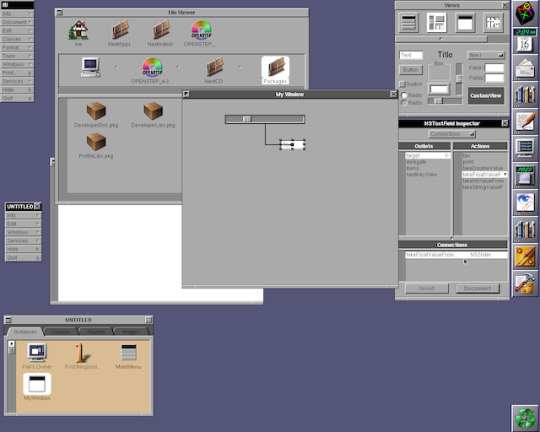
何度も仕事でインストールし、この上でプログラムを開発したので、何とも懐かしい気分になりました。
今ではメインメモリが16GBでハードディスクが256GBなんていうスペックのコンピューターで仕事をしていましたが、当時はメイン…
View On WordPress
0 notes
